Dynamic Performance and Crashworthiness Assessment of Honeycomb Reinforced Tubular Pipe in the Jacket Platform under Ship Collision
Abstract
:1. Introduction
2. Description of the Honeycomb Structure and the Verification of FE Simulation
2.1. Description of the Honeycomb Structure
2.2. Conventional Crashworthiness Index
2.3. Verification of the FE Method for the Simulation of Oblique Collision with Hexagonal Honeycomb Sandwich
2.3.1. Description of the Verified Research
2.3.2. Verification Model of This Study
2.3.3. Verification Results Comparison
3. Numerical Simulation of the Proposed Honeycomb Reinforced Pipes
3.1. FE Model of the Proposed Honeycomb Reinforced Pipes
3.2. Material Model
3.3. Collision Scenarios
4. Results
4.1. Response of Honeycomb Reinforced Pipe under the Ship Impact
4.1.1. Deformation of the Unprotected and Honeycomb Reinforced Pipes
4.1.2. Folding of the Honeycomb Structures
4.1.3. Influence of Length–Thickness Ratio on the Collision Resistance
4.2. Evaluation of Crashworthiness under Different Collision Velocities
4.2.1. Collision Force–Indentation Cures
4.2.2. Results of Crashworthiness Indexes
5. Discussion
5.1. Influence of the Ship Impact Angle
5.2. The Proposed Crashworthiness Index of Offset Sliding (OS)
5.3. Evaluation of Crashworthiness under Different Collision Angles
5.3.1. Collision Force–Indentation Cures
5.3.2. Results of Crashworthiness Indexes
5.4. Influence of the Side Collision
6. Conclusions
Author Contributions
Funding
Institutional Review Board Statement
Informed Consent Statement
Data Availability Statement
Conflicts of Interest
References
- Yu, Z.; Amdahl, J. A review of structural responses and design of offshore tubular structures subjected to ship impacts. Ocean Eng. 2018, 154, 177–203. [Google Scholar] [CrossRef]
- Mujeeb-Ahmed, M.P.; Seo, J.K.; Paik, J.K. Probabilistic approach for collision risk analysis of powered vessel with offshore platforms. Ocean Eng. 2018, 151, 206–221. [Google Scholar] [CrossRef]
- Mujeeb-Ahmed, M.P.; Paik, J.K. A probabilistic approach to determine design loads for collision between an offshore supply vessel and offshore installations. Ocean Eng. 2019, 173, 358–374. [Google Scholar] [CrossRef]
- PSA (The Petroleum Safety Authority Norway). Investigation Report Following Collision between Big Orange XVIII and Ekofisk 2/4-W. In The Petroleum Safety Authority Norway; Investigation Report; Petroleum Safety Authority Norway: Stavanger, Norway, 2009. [Google Scholar]
- NORSOK N-003; Actions and Action Effects. NORSOK Standard N-003 REV; Standards Norway: Lysaker, Norway, 1999.
- ISO 19902:2007(E); Petroleum and Natural Gas Industries—Fixed Steel Offshore Structures. First Edition; The International Organization for Standardization: Geneva, Switzerland, 2007.
- DNVGL-RP-C204. Design Against Accidental Loads. Norway. Edition August 2017. Available online: https://standards.globalspec.com/std/10183659/dnvgl-rp-c204 (accessed on 20 August 2022).
- American Petroleum Institute. API Recommended Practice 2A-WSD (RP 2A-WSD) Errata and Supplement 3; American Petroleum Institute: Washington, DC, USA, 2007. [Google Scholar]
- Liu, X.; Jiang, D.; Liufu, K.; Fu, J.; Liu, Q.; Li, Q. Numerical investigation into impact responses of an offshore wind turbine jacket foundation subjected to ship collision. Ocean Eng. 2022, 248, 110825. [Google Scholar] [CrossRef]
- Moulas, D.; Shafiee, M.; Mehmanparast, A. Damage analysis of ship collisions with offshore wind turbine foundations. Ocean Eng. 2017, 143, 149–162. [Google Scholar] [CrossRef]
- Sun, B.; Hu, Z.; Wang, G. An analytical method for predicting the ship side structure response in raked bow collisions. Mar. Struct. 2015, 41, 288–311. [Google Scholar] [CrossRef]
- Rigueiro, C.; Ribeiro, J.; Santiago, A. Numerical assessment of the behaviour of a fixed offshore platform subjected to ship collision. Procedia Eng. 2017, 199, 2494–2499. [Google Scholar] [CrossRef]
- Li, L.; Hu, Z.; Jiang, Z.; Cen, S. Plastic and Elastic Responses of a Jacket Platform Subjected to Ship Impacts. Math. Probl. Eng. 2013, 2013, 790586. [Google Scholar] [CrossRef]
- Travanca, J.; Hao, H. Dynamics of steel offshore platforms under ship impact. Appl. Ocean Res. 2014, 47, 352–372. [Google Scholar] [CrossRef]
- Han, Z.W.; Li, C.; Deng, Y.H.; Liu, J. The analysis of anti-collision performance of the fender with offshore wind turbine tripod impacted by ship and the coefficient of restitution. Ocean Eng. 2019, 194, 1–17. [Google Scholar] [CrossRef]
- Yue, X.; Han, Z.; Li, C.; Zhao, X. The study on structure design of fender of offshore wind turbine based on fractal feature during collision with ship. Ocean Eng. 2021, 236, 109100. [Google Scholar] [CrossRef]
- Kiani, K.; Pakdaman, H. On the nonlocality of bilateral vibrations of single-layered membranes from vertically aligned double-walled carbon nanotubes. Phys. Scripta. 2020, 95, 035221. [Google Scholar] [CrossRef]
- Yousefi, E.; Sheidaei, A.; Mahdavi, M.; Baniassadi, M.; Baghani, M.; Faraji, G. Effect of nanofiller geometry on the energy absorption capability of coiled carbon nanotube composite material. Compos. Sci. Technol. 2017, 153, 222–231. [Google Scholar] [CrossRef]
- Birman, V.; Kardomateas, G.A. Review of current trends in research and applications of sandwich structures. Compos. B Eng. 2018, 142, 221–240. [Google Scholar] [CrossRef]
- Crupi, V.; Epasto, G.; Guglielmino, E. Comparison of aluminium sandwiches for lightweight ship structures: Honeycomb vs. foam. Mar. Struct. 2013, 30, 74–96. [Google Scholar] [CrossRef]
- Wang, Z.G. Recent advances in novel metallic honeycomb structure. Compos. B Eng. 2019, 166, 731–741. [Google Scholar] [CrossRef]
- He, Q.; Ma, D. Parametric study and multi-objective crashworthiness optimisation of reinforced hexagonal honeycomb under dynamic loadings. Int. J. Crashworthiness 2015, 20, 495–509. [Google Scholar] [CrossRef]
- Radosław, C.; Roman, G.; Danuta, M. Experimental Study on Static and Dynamic Response of Aluminum Honeycomb Sandwich Structures. Materials 2022, 15, 1793. [Google Scholar]
- Gao, Q.; Zhao, X.; Wang, C.; Wang, L.; Ma, Z. Multi-objective crashworthiness optimization for an auxetic cylindrical structure under axial impact loading. Mater. Des. 2018, 143, 120–130. [Google Scholar] [CrossRef]
- Gao, Q.; Liao, W.; Wang, L. On the low-velocity impact responses of auxetic double arrowed honeycomb. Aerosp. Sci. Technol. 2020, 98, 105698. [Google Scholar] [CrossRef]
- Pan, J.; Fang, H.; Xu, M.; Xue, X. Dynamic performance of a sandwich structure with honeycomb composite core for bridge pier protection from vehicle impact. Thin-Walled Struct. 2020, 157, 107010. [Google Scholar] [CrossRef]
- Wang, Z.; Tian, H.; Lu, Z.; Yao, S.; Zhou, W. Theoretical assessment methodology on axial compressed hexagonal honeycomb’s energy absorption capability. J. Mech. Adv. Mater. Struct. 2016, 23, 503–512. [Google Scholar] [CrossRef]
- Wang, Z.; Wang, X.; Liu, K.; Zhang, J.; Lu, Z. Crashworthiness index of honeycomb sandwich structures under low-speed oblique impact. Int. J. Mecha. Sci. 2021, 208, 106683. [Google Scholar] [CrossRef]
- Dai, L.; Ehlers, S.; Rausand, M.; Utne, I.B. Risk of collision between service vessels and offshore wind turbines. Reliab. Eng. Syst. Saf. 2013, 109, 18–31. [Google Scholar] [CrossRef]
- Zheng, Z.; Geng, B.; Yuan, P.; Shang, N.; Wei, S.; Hu, Z. Reliability of butterfly type connection structure of bridge pier FRP composite anti-collision sleeve box. J. Vib. Shock 2020, 39, 281–288. (In Chinese) [Google Scholar]
- Cowper, G.R.; Symonds, P.S. Strain-Hardening and Strain-Rate Effects in the Impact Loading of Cantilever Beams. Ph.D. Thesis, Brown University, Providence, RI, USA, 1957. [Google Scholar]
- Storheim, M.; Amdahl, J.; Martens, I. On the accuracy of fracture estimation in collision analysis of ship and offshore structures. Mar. Struct. 2015, 44, 254–287. [Google Scholar] [CrossRef]
- Guo, X.; Zhang, C.; Chen, Z. Dynamic performance and damage evaluation of a scoured double-pylon cable-stayed bridge under ship impact. Eng. Struct. 2020, 216, 110772. [Google Scholar] [CrossRef]
- Fan, Y.B.; Wang, Z.S. Dynamic plastic collapse mechanics of honeycomb structures under different plane deformation. J. Beijing Univ. Aeronaut. Astronaut. 2012, 38, 1464–1468. (In Chinese) [Google Scholar]
- Kaya, Y. Microstructural, Mechanical and Corrosion Investigations of Ship Steel-Aluminum Bimetal Composites Produced by Explosive Welding. Metals 2018, 8, 544. [Google Scholar] [CrossRef]
- Do, Q.T.; Huynh, V.V.; Vu, M.T.; Tuyen, V.V.; Pham-Thanh, N.; Tra, T.H.; Vu, Q.-V.; Cho, S.-R. A New Formulation for Predicting the Collision Damage of Steel Stiffened Cylinders Subjected to Dynamic Lateral Mass Impact. Appl. Sci. 2020, 10, 3856. [Google Scholar] [CrossRef]
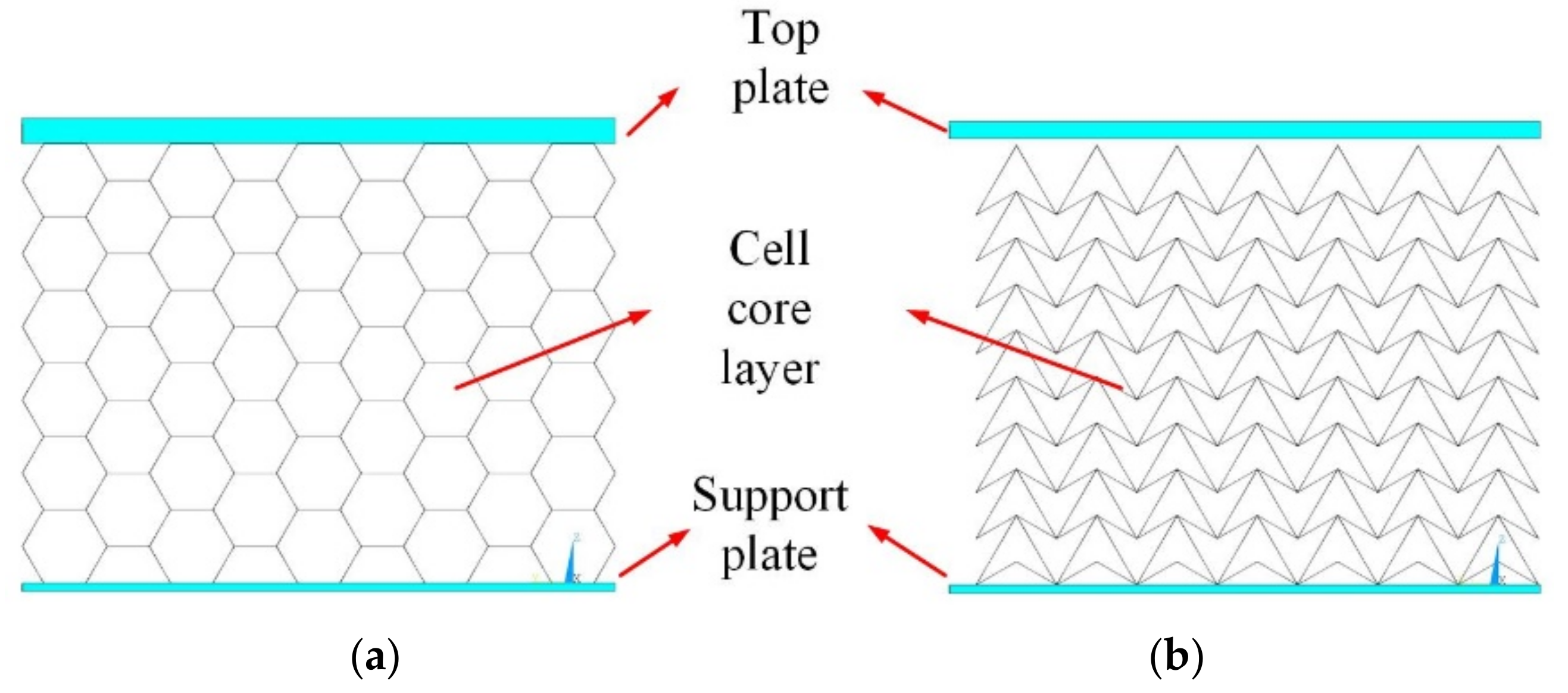
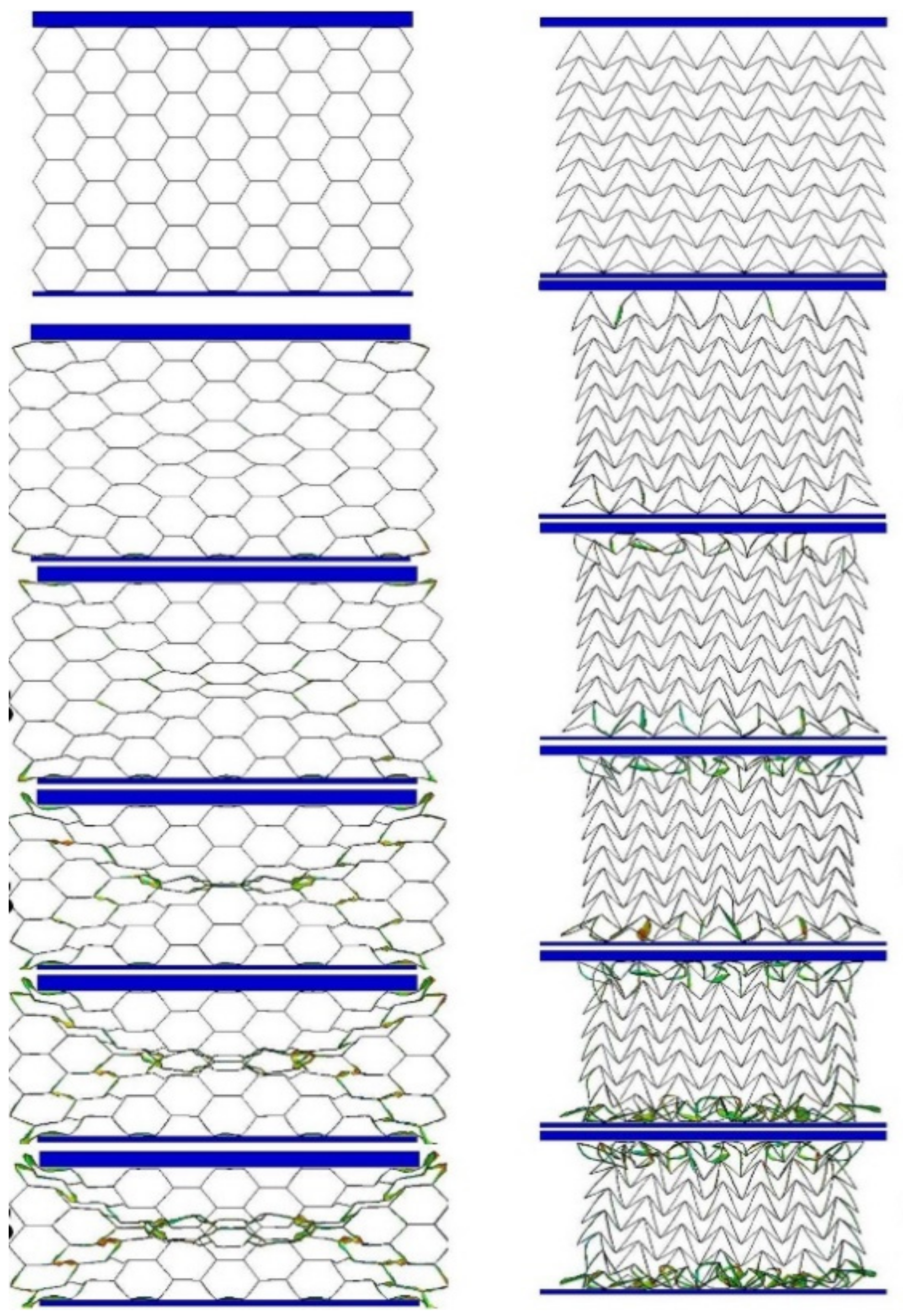


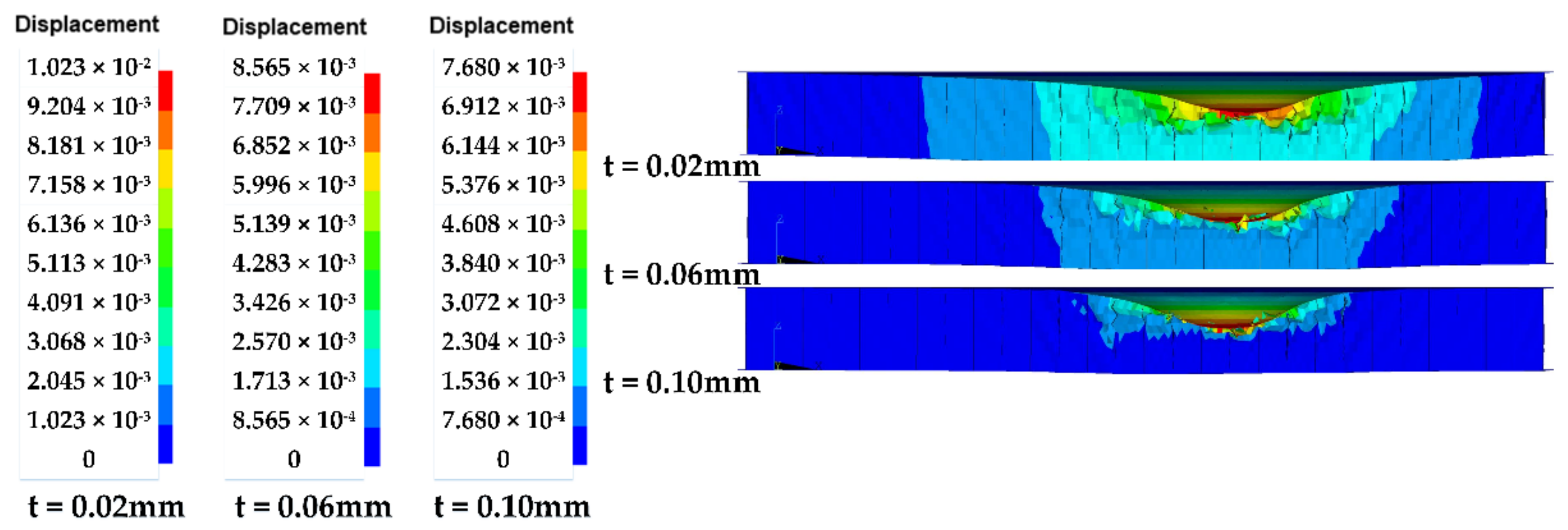
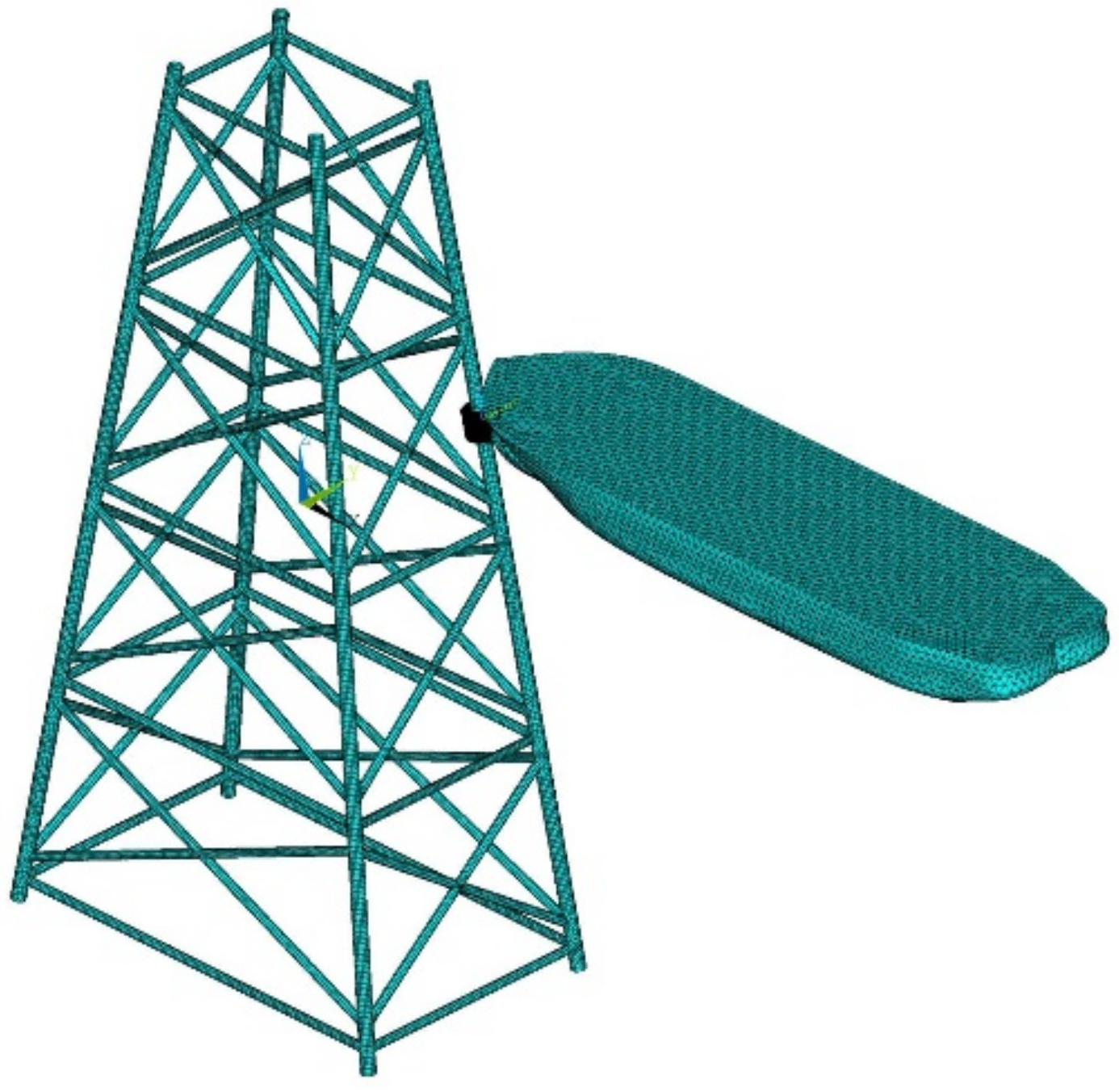

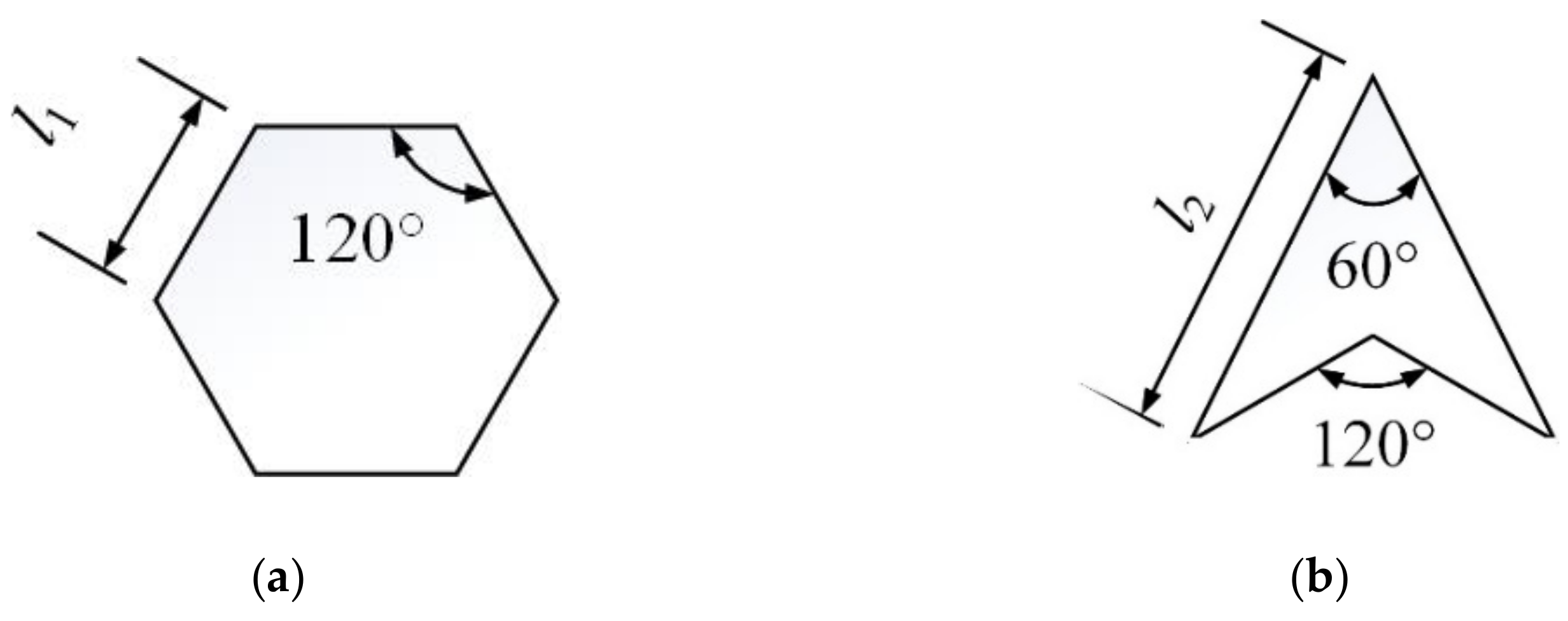
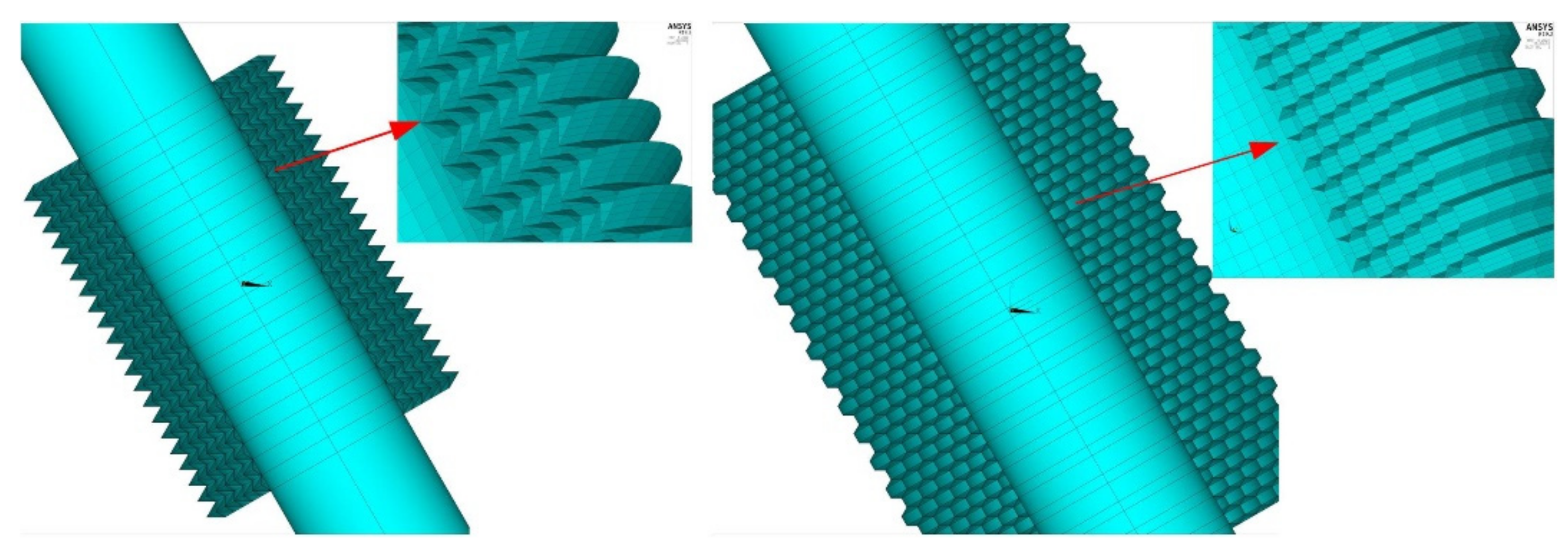


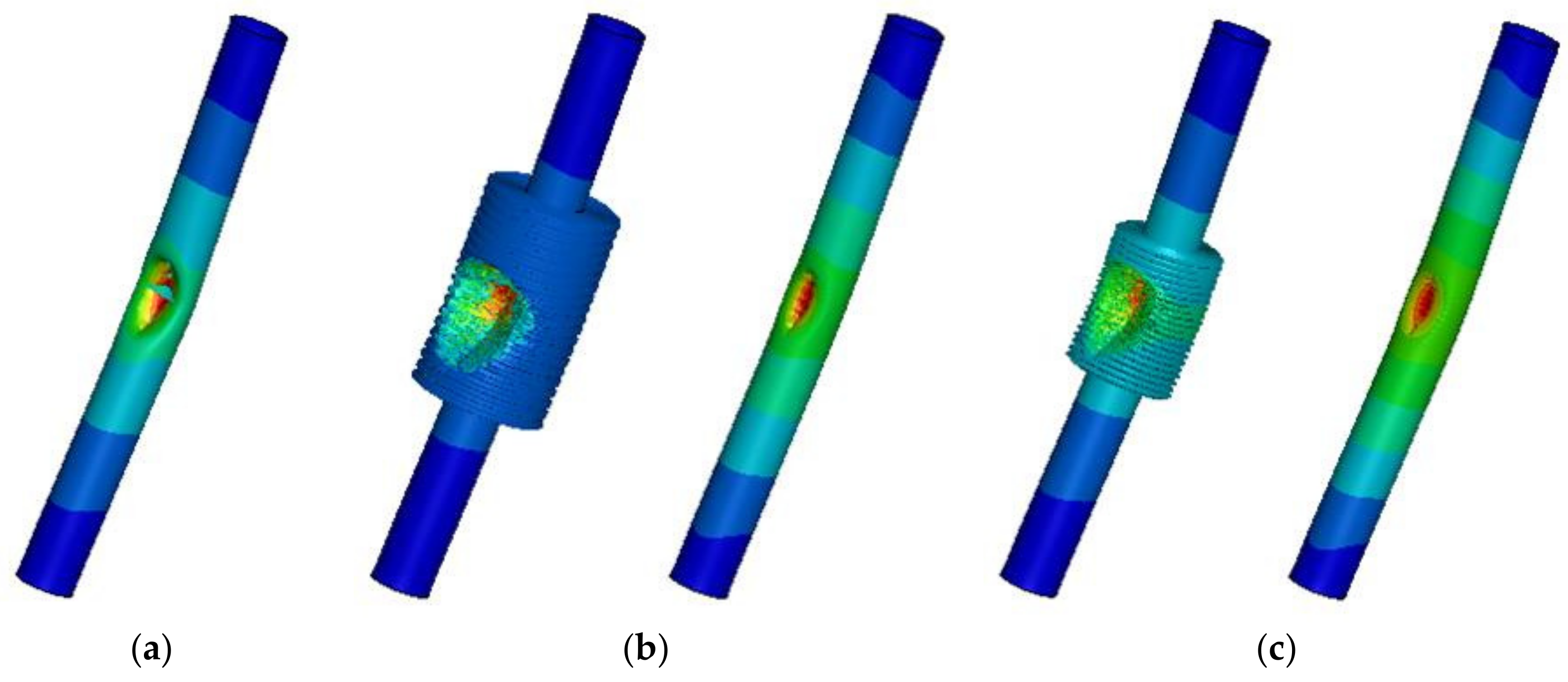
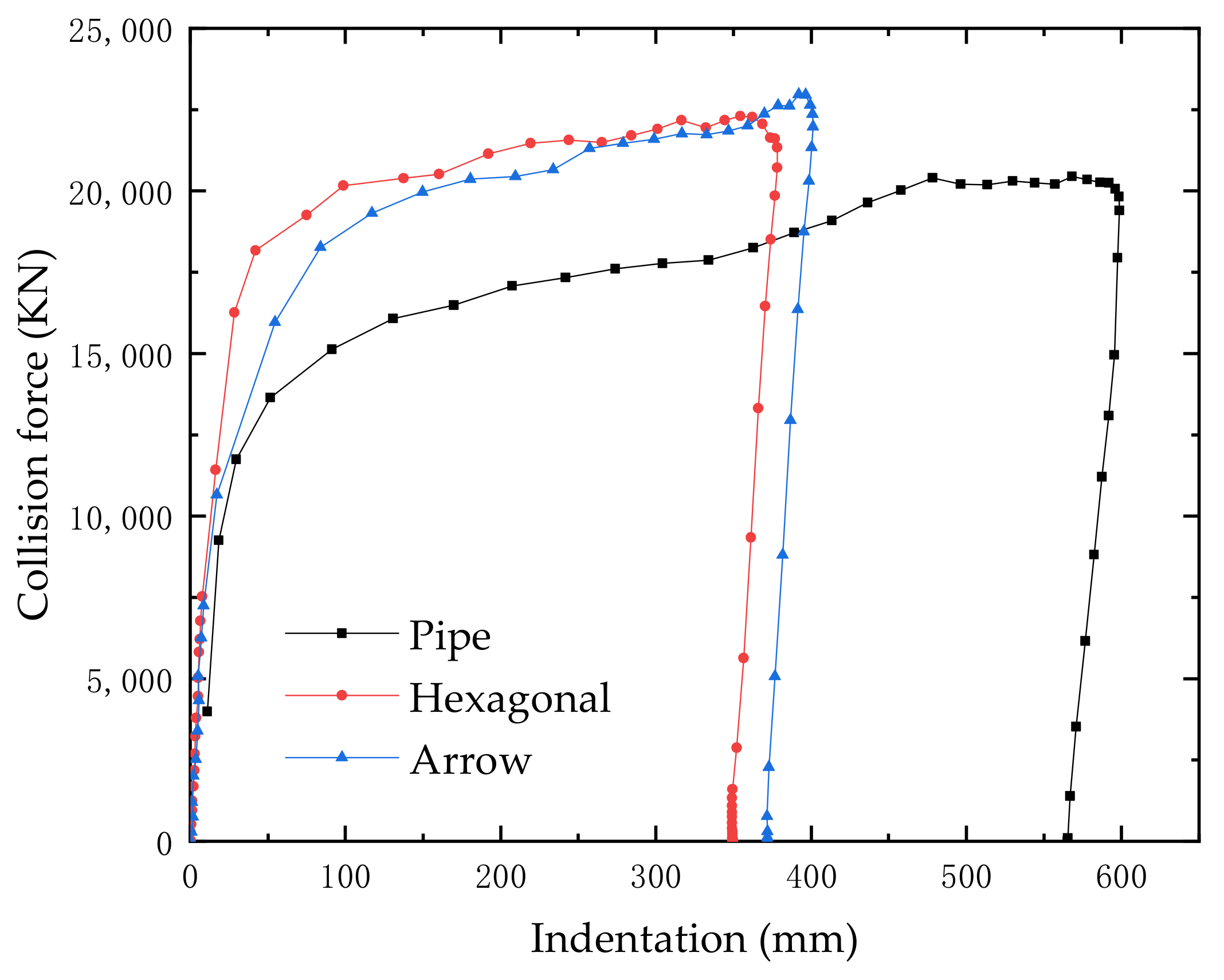
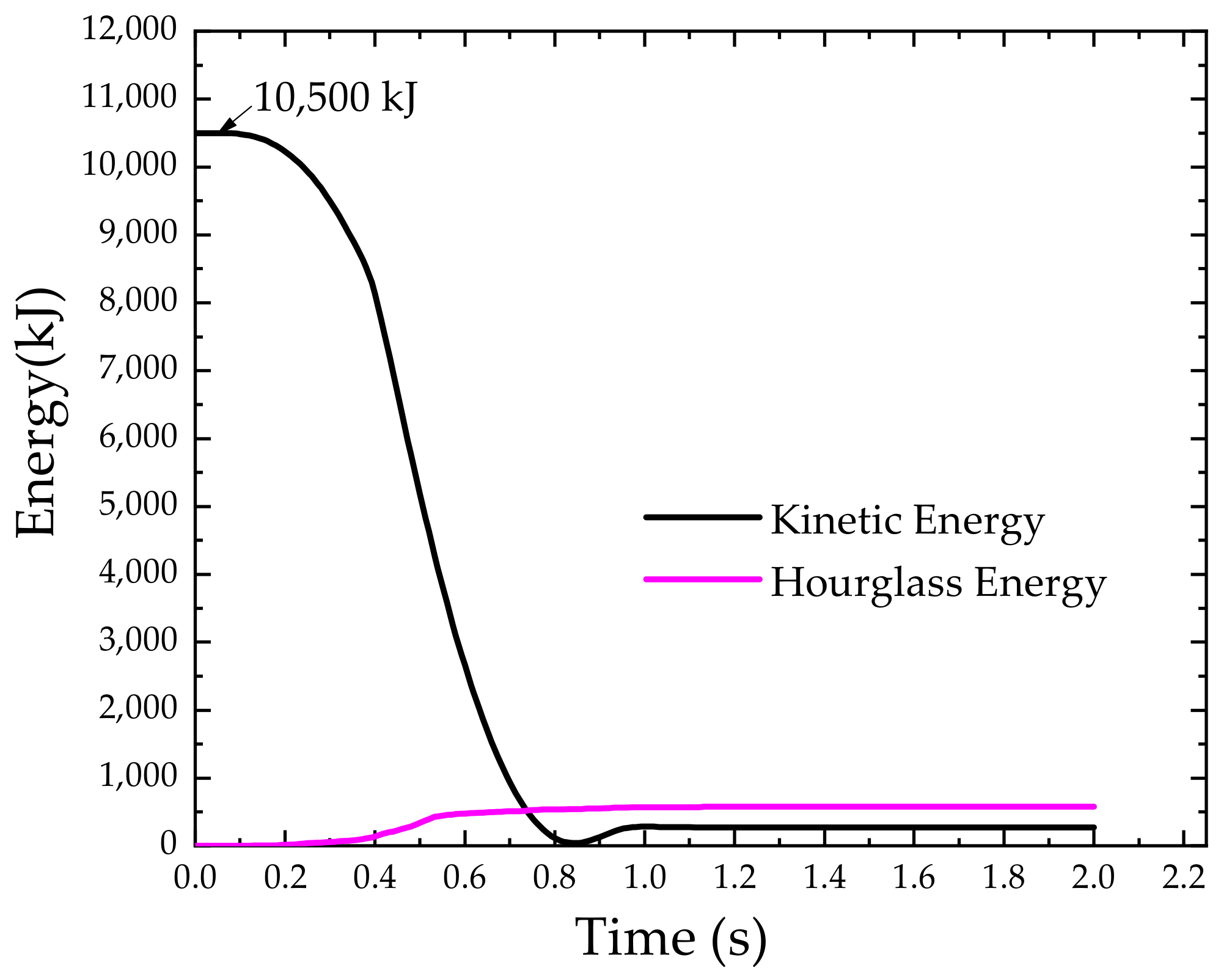

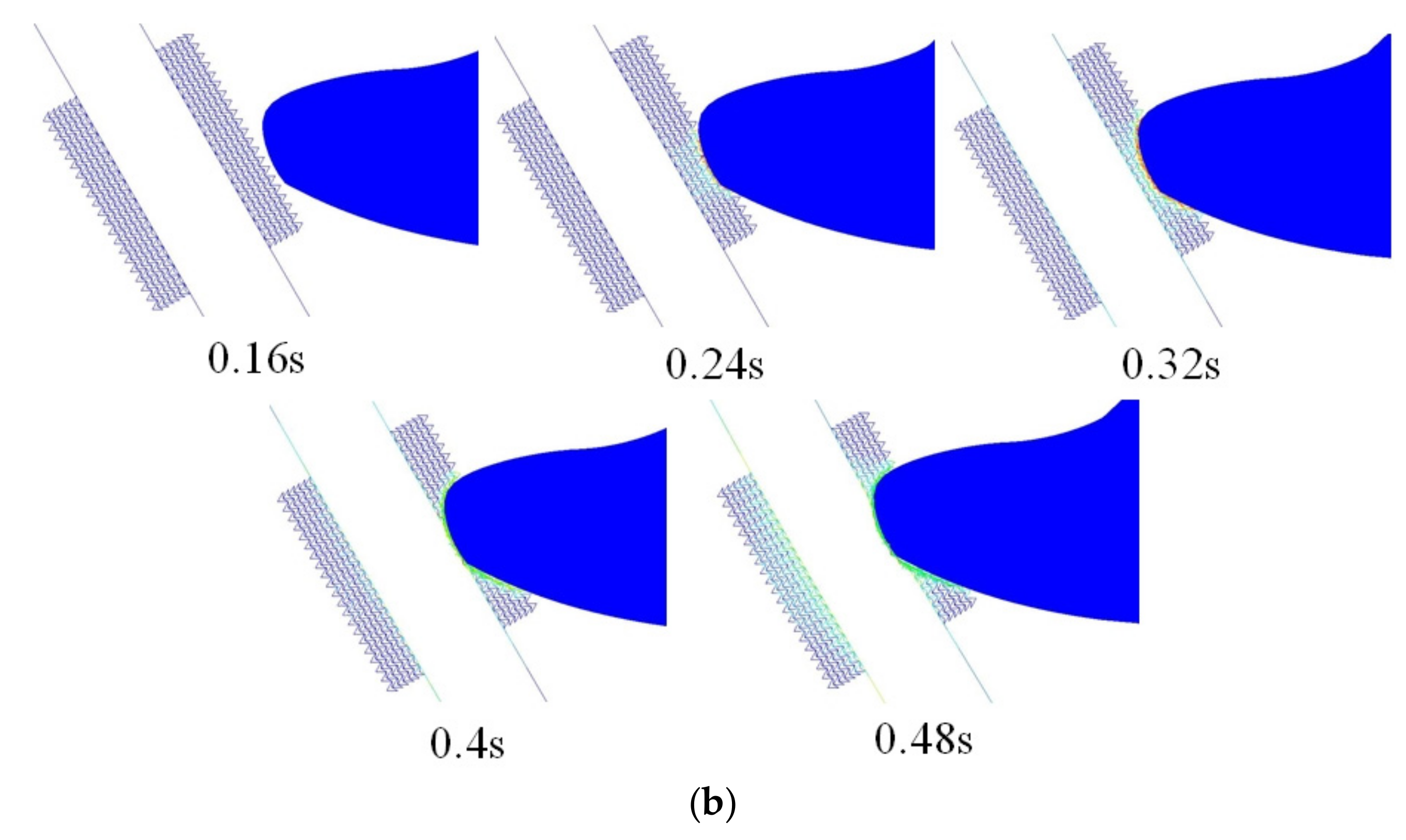
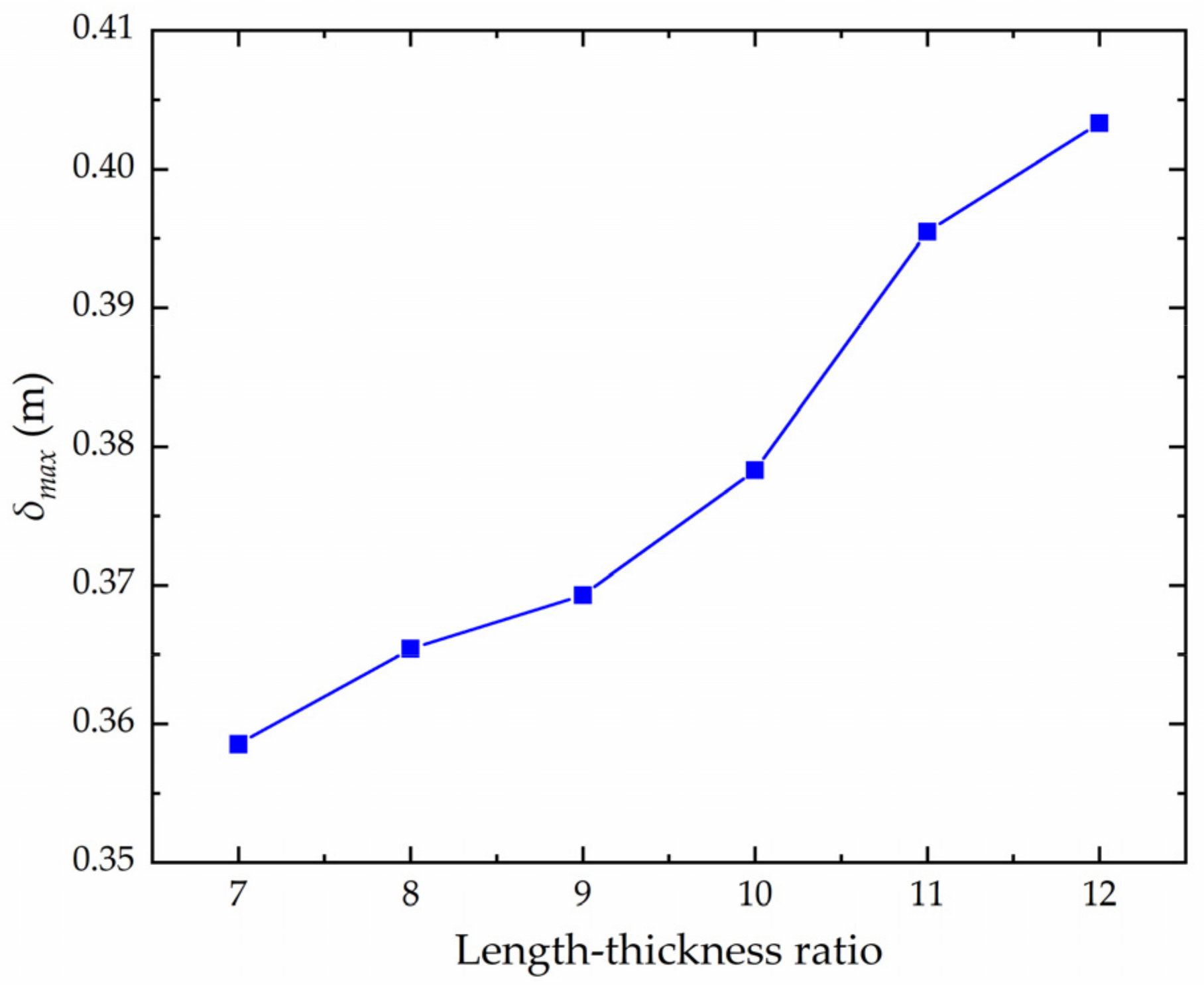
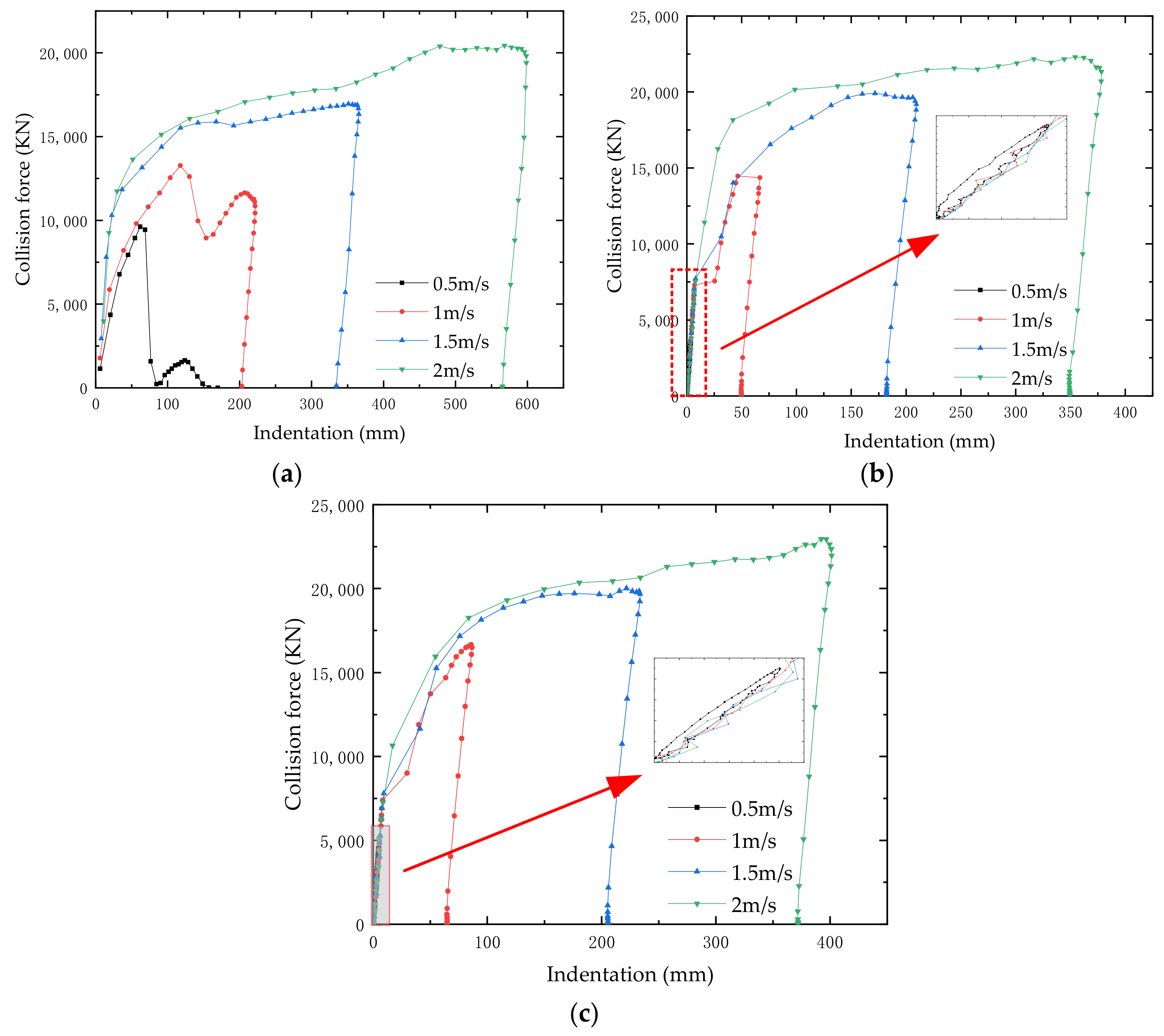
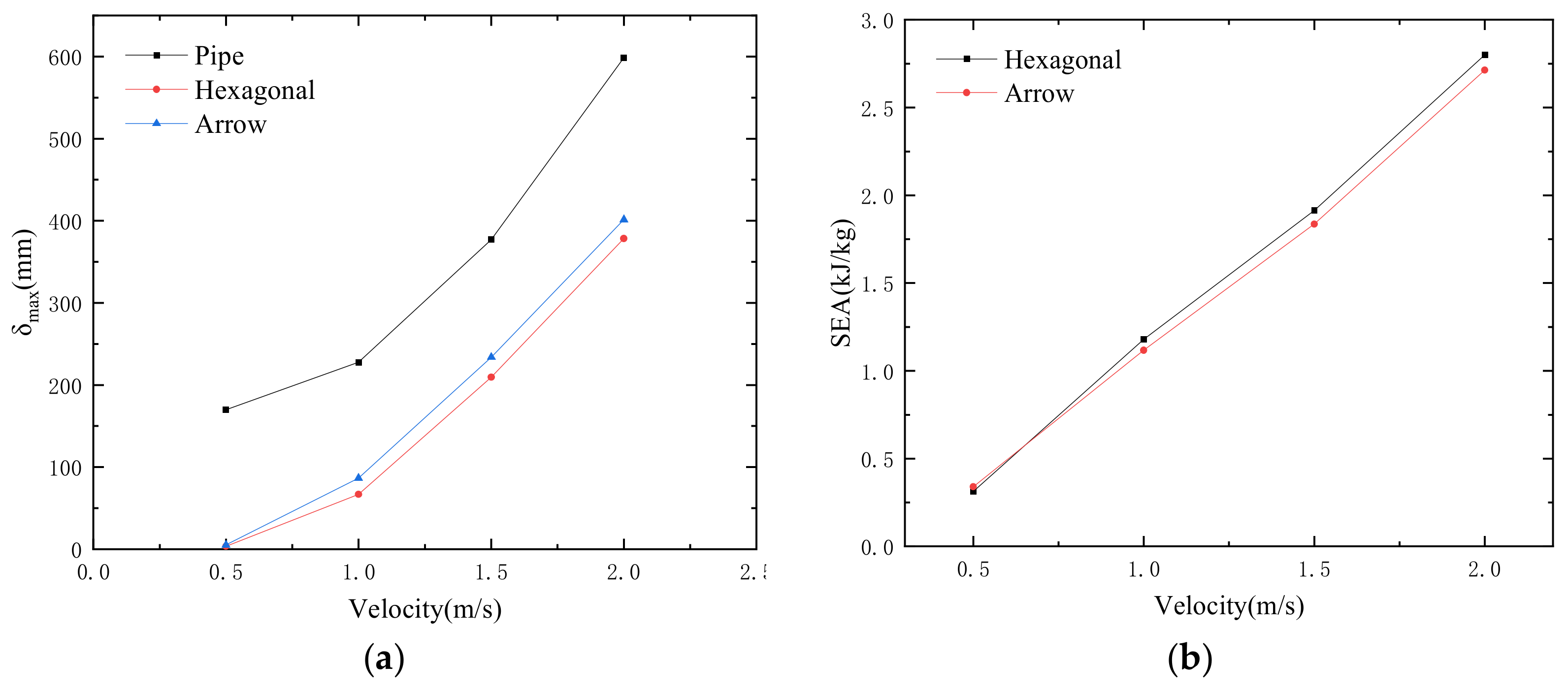


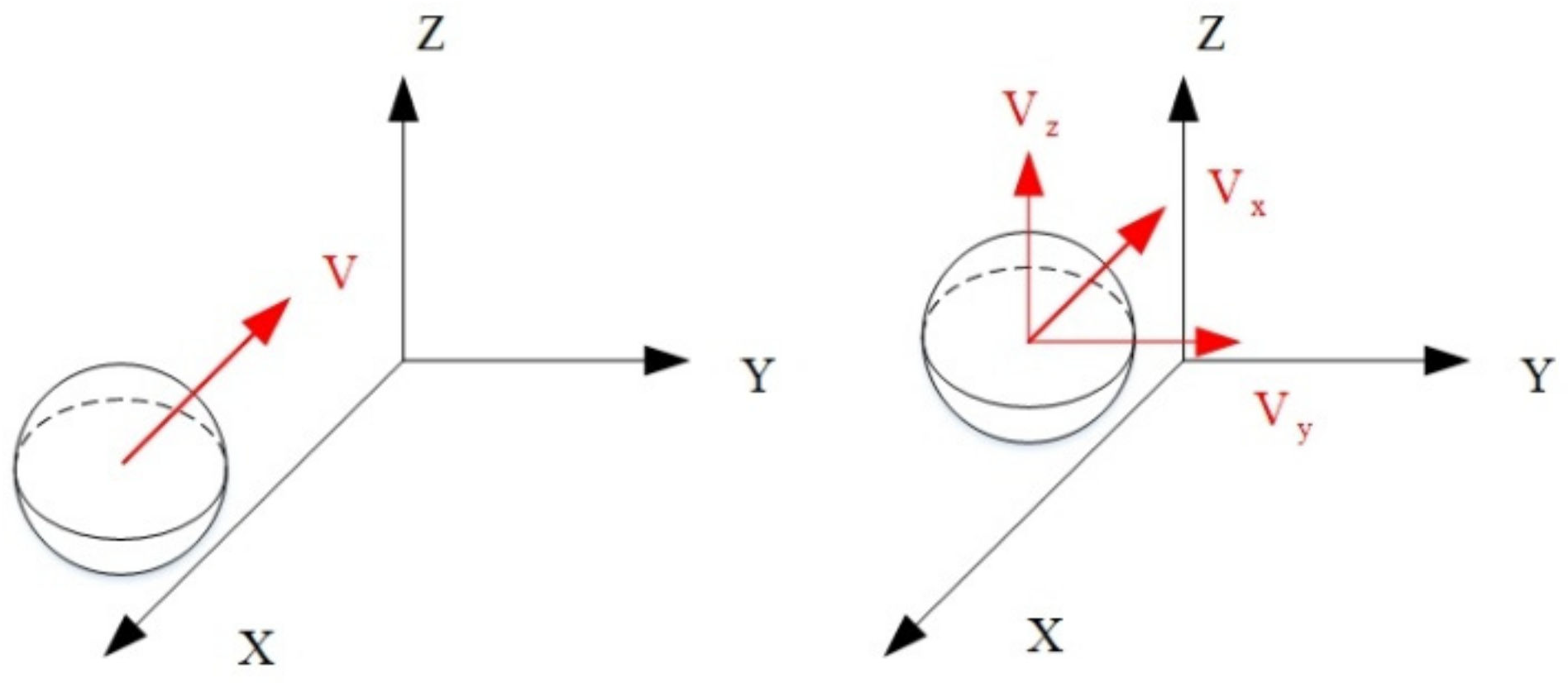
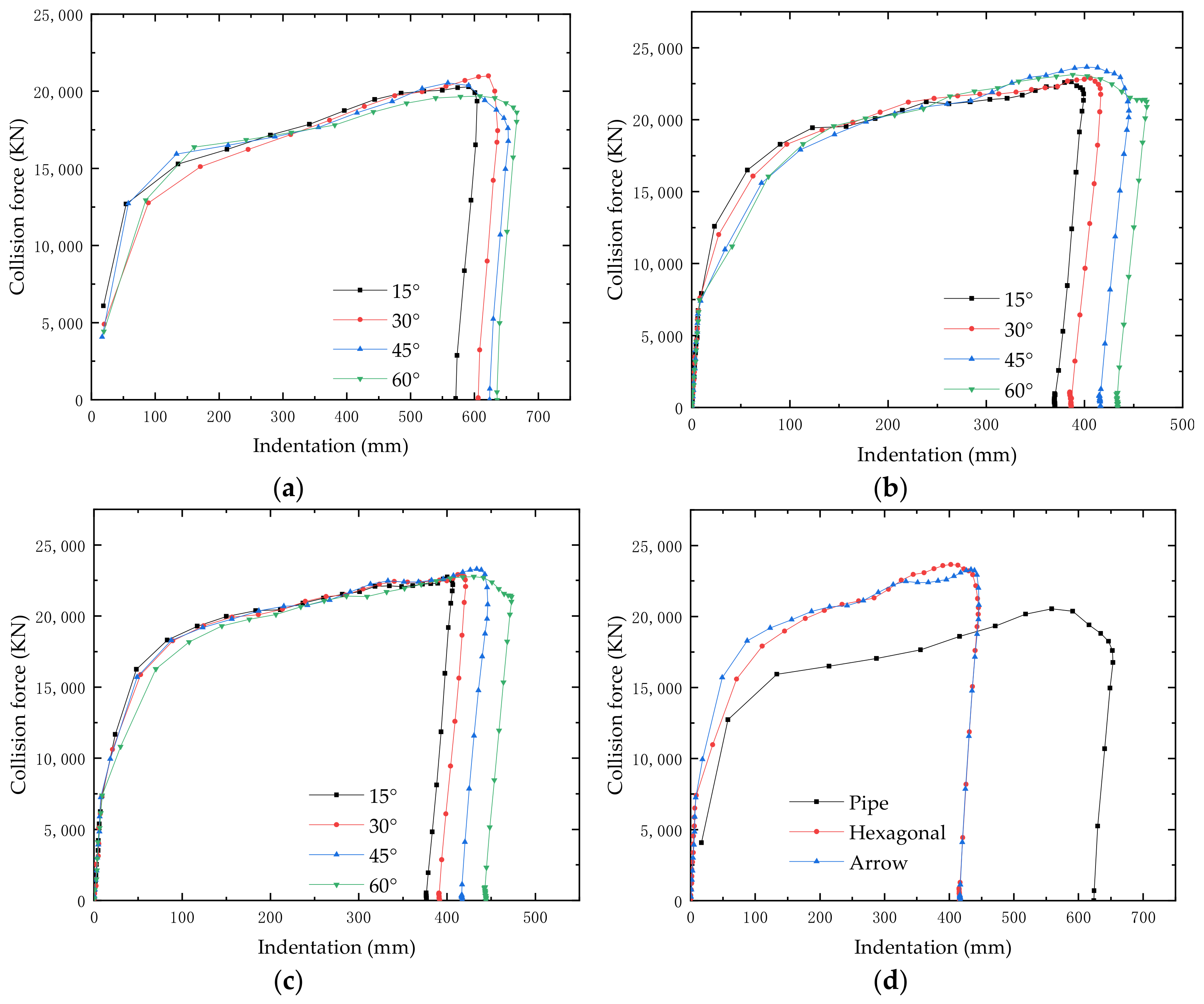
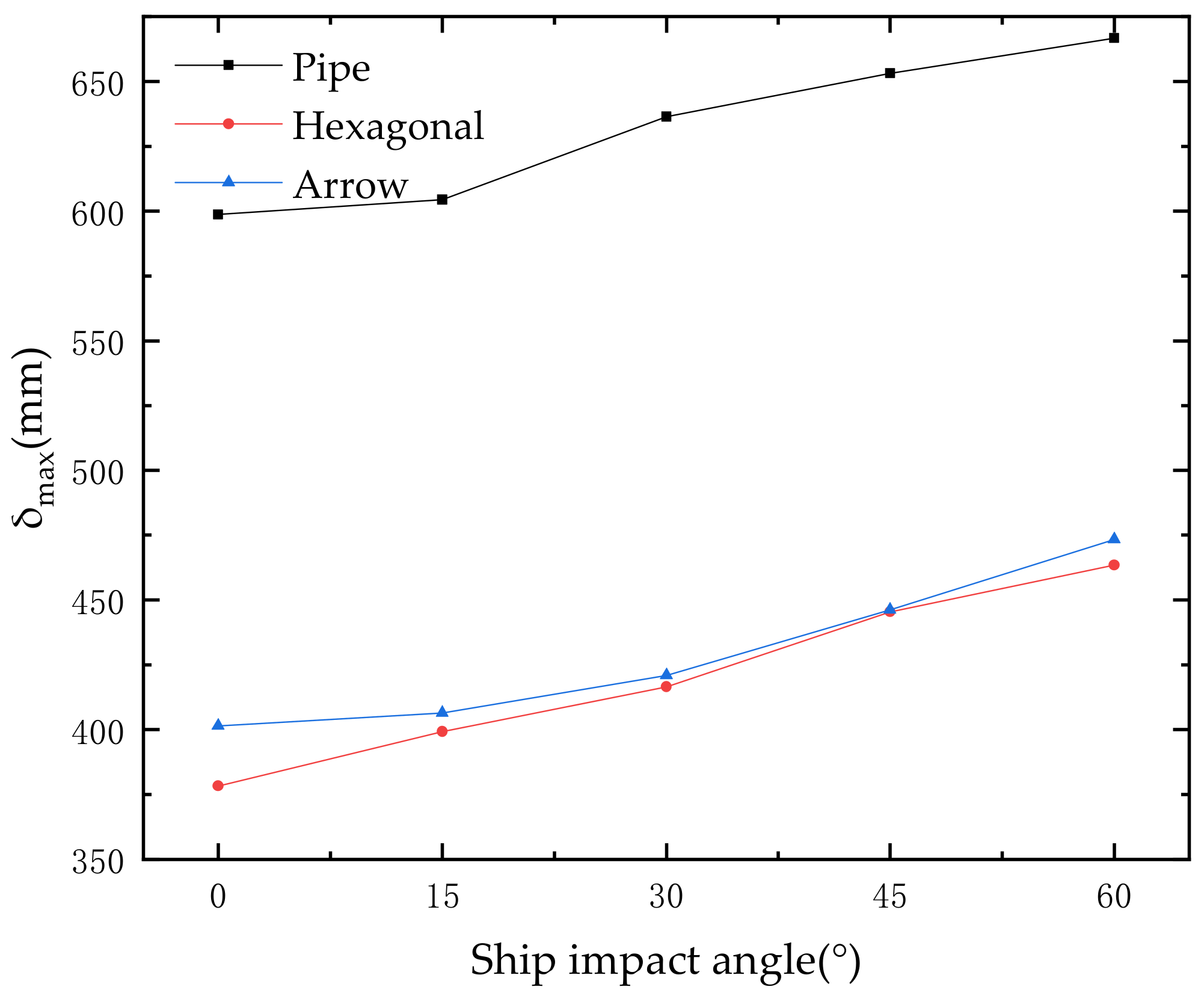

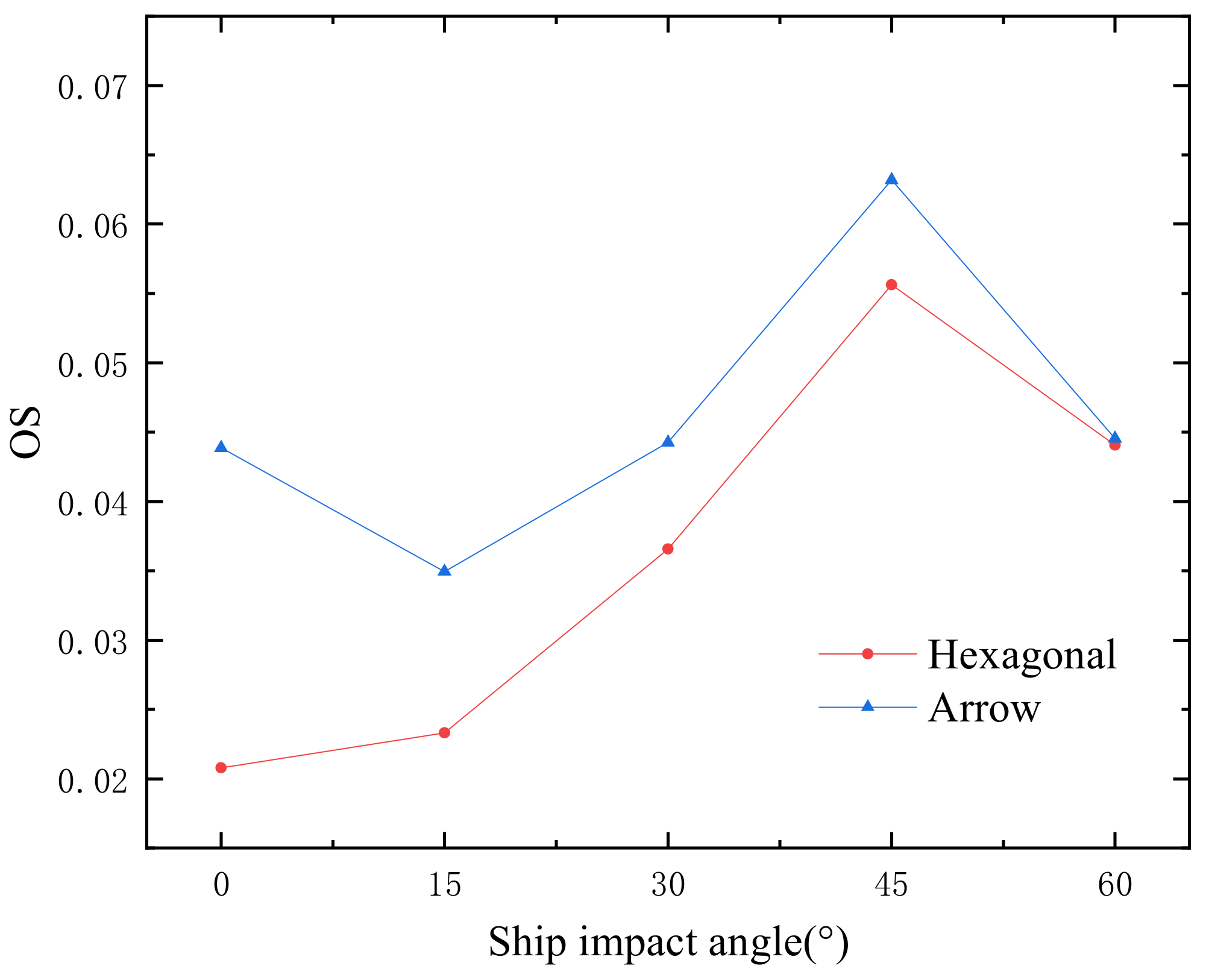
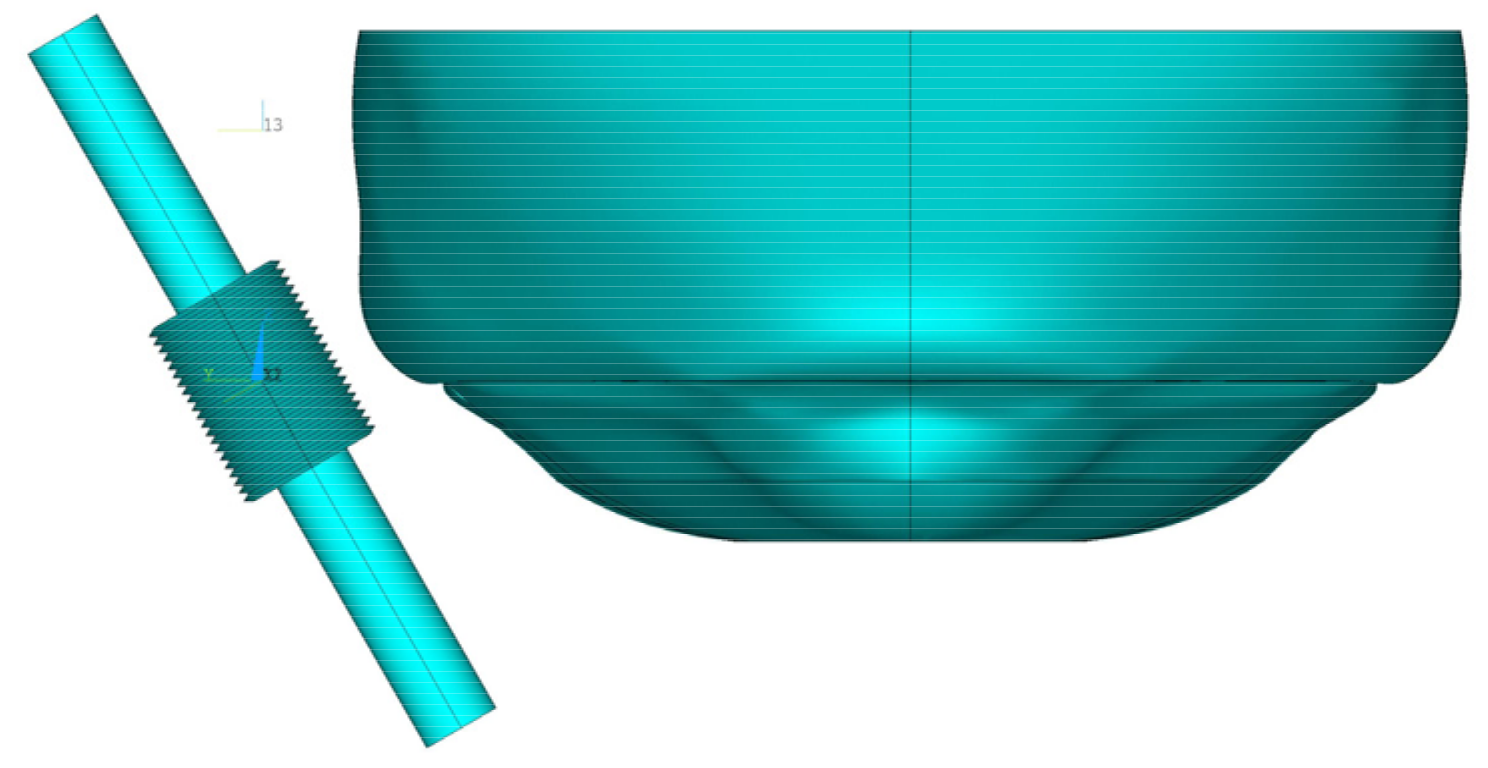
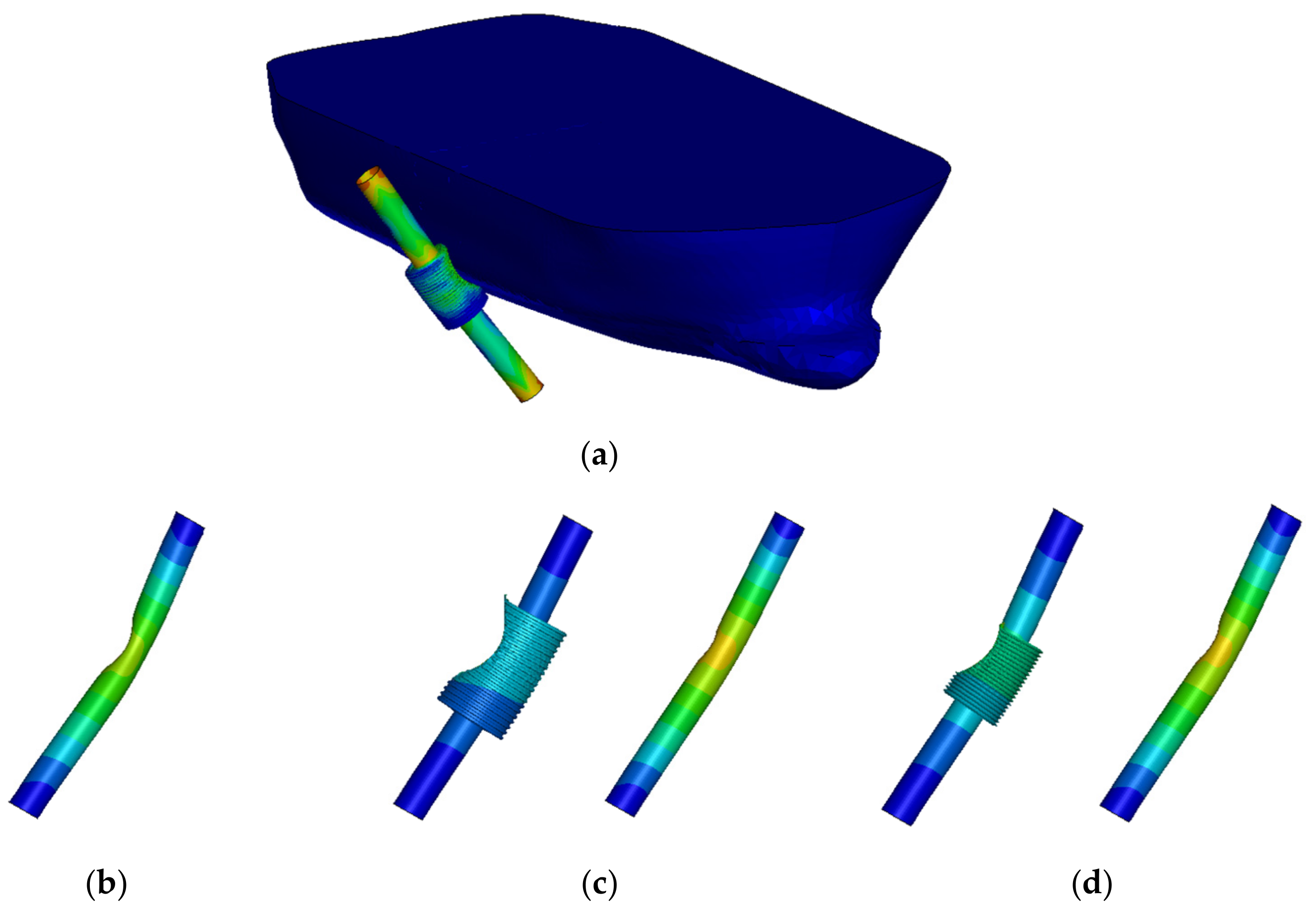
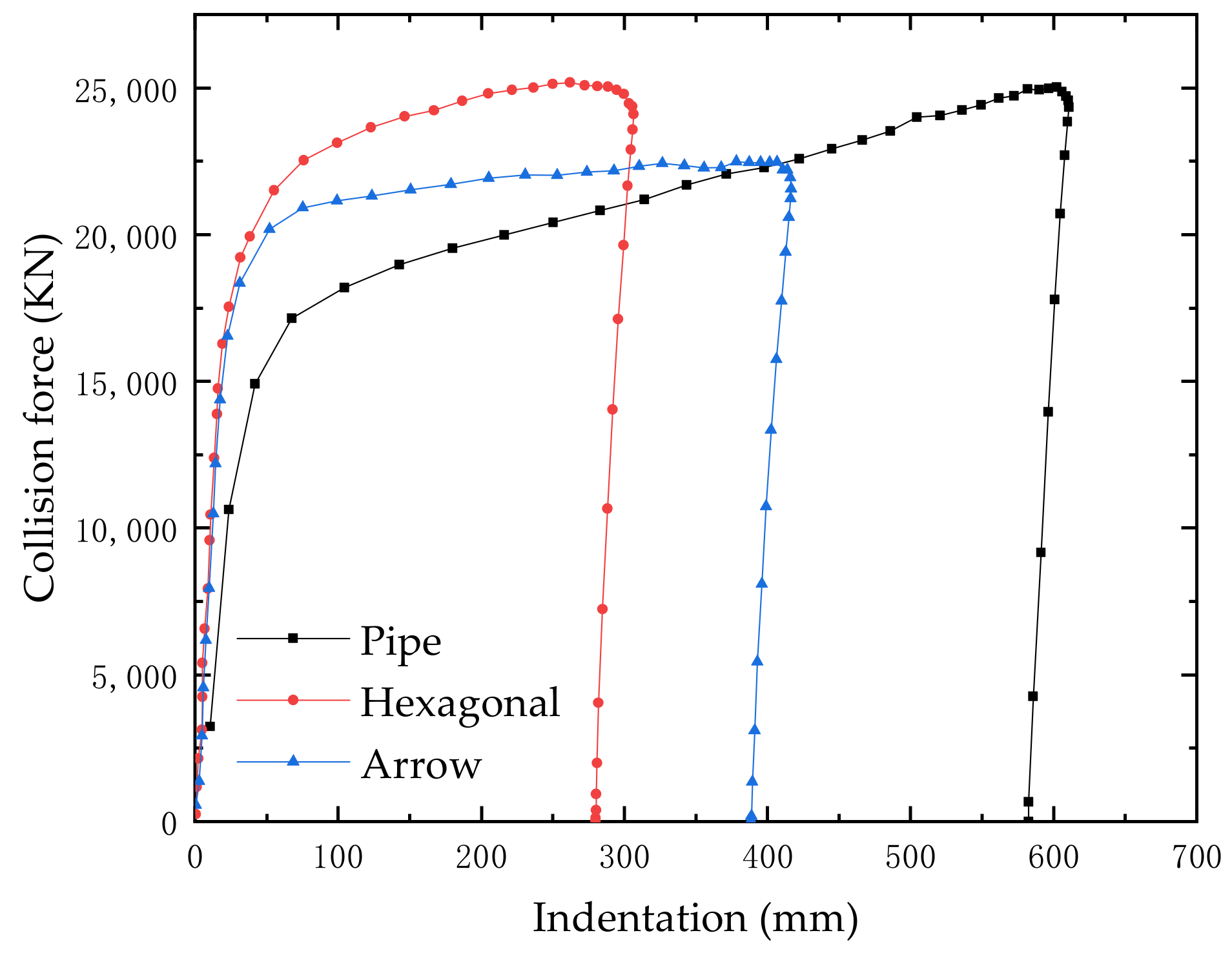
| t (mm) | Results of This Study δmax (mm) | Error % |
|---|---|---|
| 0.02 | 10.2 | 10.6 |
| 0.06 | 8.57 | 12.1 |
| 0.10 | 7.68 | 16.8 |
| t (mm) | Results of This Study SEA (J/kg) | Error % |
|---|---|---|
| 0.02 | 438.11 | 2.6 |
| 0.06 | 386.69 | 4.6 |
| 0.10 | 344.41 | 5.7 |
| Material Attributes | Value |
|---|---|
| Density (ρ) (kg/m3) | 7800 |
| Elastic modulus (E) (GPa) | 210 |
| Poisson’s ratio (ν) | 0.3 |
| Yield stress(σY) (MPa) | 235 |
| Tangent modulus(Etan) (GPa) | 1.18 |
| Strain rate parameter (P) | 5 |
| Strain rate parameter (C) | 40.4 |
| Failure strain (εf) | 0.2 |
| Material Attributes | Value |
|---|---|
| Density, ρ (kg/m3) | 2700 |
| Elastic modulus, E (GPa) | 62 |
| Poisson’s ratio, ν | 0.3 |
| Yield stress, σY (MPa) | 225 |
| Tangent modulus, Etan (MPa) | 50 |
| Strain rate parameter (P) | 4 |
| Strain rate parameter (C) | 6000 |
| Failure strain (εf) | 0.35 |
| Pipe | Collision Speed v (m/s) | Impact Angle θ (°) |
|---|---|---|
| Unreinforced | 0.5 | 0 15 |
| Hexagonal honeycomb reinforced | 1.0 | 30 |
| Arrow honeycomb reinforced | 1.5 | 45 |
| 2.0 | 60 |
| Configurations | Velocity (m/s) | δmax of Pipe (mm) | SEA of Honeycomb (J/kg) |
|---|---|---|---|
| Pipe | 0.5 | 169.9275 | \ |
| 1 | 227.5173 | \ | |
| 1.5 | 376.9672 | \ | |
| 2 | 598.7231 | \ | |
| Hexagonal honeycomb | 0.5 | 3.444425 | 312.0699 |
| 1 | 66.67842 | 1179.4438 | |
| 1.5 | 209.4099 | 1913.6876 | |
| 2 | 378.2971 | 2800.1272 | |
| Arrow honeycomb | 0.5 | 5.059117 | 339.5539 |
| 1 | 86.55258 | 1116.8778 | |
| 1.5 | 233.8068 | 1835.8028 | |
| 2 | 401.4445 | 2713.0463 |
| Configurations | Ship Impact Angle θ (°) | δmax (mm) | SEA (J/kg) | OS |
|---|---|---|---|---|
| Unreinforced Pipe | 0 | 598.7231 | \ | \ |
| 15 | 604.3580 | \ | \ | |
| 30 | 636.4105 | \ | \ | |
| 45 | 653.0783 | \ | \ | |
| 60 | 666.6496 | \ | \ | |
| Hexagonal honeycomb reinforced pipe | 0 | 378.2971 | 2800.1272 | 0.020797 |
| 15 | 399.3373 | 2755.0076 | 0.023327 | |
| 30 | 416.5061 | 2594.8769 | 0.036576 | |
| 45 | 445.3873 | 2314.7692 | 0.055623 | |
| 60 | 463.4103 | 2096.1266 | 0.044072 | |
| Arrow honeycomb reinforced pipe | 0 | 401.4445 | 2713.0463 | 0.043861 |
| 15 | 406.5543 | 2658.6255 | 0.034948 | |
| 30 | 420.9884 | 2469.0002 | 0.044253 | |
| 45 | 446.1254 | 2205.7211 | 0.063182 | |
| 60 | 473.3636 | 1952.8885 | 0.044550 |
Publisher’s Note: MDPI stays neutral with regard to jurisdictional claims in published maps and institutional affiliations. |
© 2022 by the authors. Licensee MDPI, Basel, Switzerland. This article is an open access article distributed under the terms and conditions of the Creative Commons Attribution (CC BY) license (https://creativecommons.org/licenses/by/4.0/).
Share and Cite
Lin, H.; Han, C.; Yang, L.; Karampour, H.; Luan, H.; Han, P.; Xu, H.; Zhang, S. Dynamic Performance and Crashworthiness Assessment of Honeycomb Reinforced Tubular Pipe in the Jacket Platform under Ship Collision. J. Mar. Sci. Eng. 2022, 10, 1194. https://doi.org/10.3390/jmse10091194
Lin H, Han C, Yang L, Karampour H, Luan H, Han P, Xu H, Zhang S. Dynamic Performance and Crashworthiness Assessment of Honeycomb Reinforced Tubular Pipe in the Jacket Platform under Ship Collision. Journal of Marine Science and Engineering. 2022; 10(9):1194. https://doi.org/10.3390/jmse10091194
Chicago/Turabian StyleLin, Hong, Chang Han, Lei Yang, Hassan Karampour, Haochen Luan, Pingping Han, Hao Xu, and Shuo Zhang. 2022. "Dynamic Performance and Crashworthiness Assessment of Honeycomb Reinforced Tubular Pipe in the Jacket Platform under Ship Collision" Journal of Marine Science and Engineering 10, no. 9: 1194. https://doi.org/10.3390/jmse10091194
APA StyleLin, H., Han, C., Yang, L., Karampour, H., Luan, H., Han, P., Xu, H., & Zhang, S. (2022). Dynamic Performance and Crashworthiness Assessment of Honeycomb Reinforced Tubular Pipe in the Jacket Platform under Ship Collision. Journal of Marine Science and Engineering, 10(9), 1194. https://doi.org/10.3390/jmse10091194








